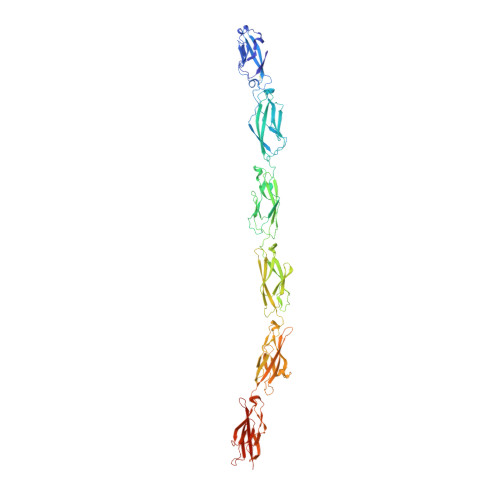Visualization of clustered protocadherin neuronal self-recognition complexes.
Brasch, J., Goodman, K.M., Noble, A.J., Rapp, M., Mannepalli, S., Bahna, F., Dandey, V.P., Bepler, T., Berger, B., Maniatis, T., Potter, C.S., Carragher, B., Honig, B., Shapiro, L.(2019) Nature 569: 280-283
- PubMed: 30971825
- DOI: https://doi.org/10.1038/s41586-019-1089-3
- Primary Citation of Related Structures:
6E6B - PubMed Abstract:
Neurite self-recognition and avoidance are fundamental properties of all nervous systems 1 . These processes facilitate dendritic arborization 2,3 , prevent formation of autapses 4 and allow free interaction among non-self neurons 1,2,4,5 . Avoidance among self neurites is mediated by stochastic cell-surface expression of combinations of about 60 isoforms of α-, β- and γ-clustered protocadherin that provide mammalian neurons with single-cell identities 1,2,4-13 . Avoidance is observed between neurons that express identical protocadherin repertoires 2,5 , and single-isoform differences are sufficient to prevent self-recognition 10 . Protocadherins form isoform-promiscuous cis dimers and isoform-specific homophilic trans dimers 10,14-20 . Although these interactions have previously been characterized in isolation 15,17-20 , structures of full-length protocadherin ectodomains have not been determined, and how these two interfaces engage in self-recognition between neuronal surfaces remains unknown. Here we determine the molecular arrangement of full-length clustered protocadherin ectodomains in single-isoform self-recognition complexes, using X-ray crystallography and cryo-electron tomography. We determine the crystal structure of the clustered protocadherin γB4 ectodomain, which reveals a zipper-like lattice that is formed by alternating cis and trans interactions. Using cryo-electron tomography, we show that clustered protocadherin γB6 ectodomains tethered to liposomes spontaneously assemble into linear arrays at membrane contact sites, in a configuration that is consistent with the assembly observed in the crystal structure. These linear assemblies pack against each other as parallel arrays to form larger two-dimensional structures between membranes. Our results suggest that the formation of ordered linear assemblies by clustered protocadherins represents the initial self-recognition step in neuronal avoidance, and thus provide support for the isoform-mismatch chain-termination model of protocadherin-mediated self-recognition, which depends on these linear chains 11 .
Organizational Affiliation:
Zuckerman Mind, Brain and Behavior Institute, Columbia University, New York, NY, USA.




















